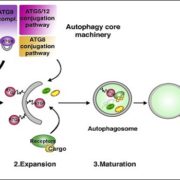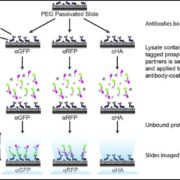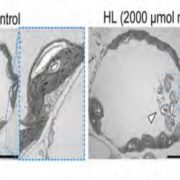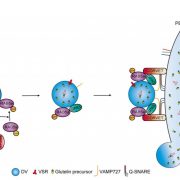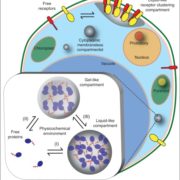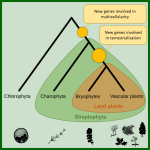A single light-responsive sizer can control multiple-fission cycles in Chlamydomonas (Curr. Biol.)
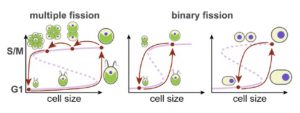 How do cells know when it is time to divide? Helt et al. explore this question using the single-celled alga Chlamydomonas. Unlike most animal and fungal cells, which tend to maintain a relatively consistent size by dividing after their size has doubled, Chlamydomonas cells can undergo several rounds of size doubling during daylight, followed by several rapid divisions (S, M and cytokinesis phases, in what is called a multiple-fission cycle) to bring them back to their standard size. This growth pattern might allow the cells to prioritize photosynthesis and growth when light is available. Several hypothesis have been suggested to explain this pattern, including control by a timer and control by a size criterion. Through experiments and modeling, the authors propose that the multiple-fission cycle can be explained through a molecular “sizer” that measures cell size by its concentration within the cell and that has two regulatory thresholds. With cell volume as its input, the sizer produces a bistable, switch-like response in TF activity and oscillator activity that can account for binary and multiple fission responses.(Summary by Mary Williams) Curr. Biol. 10.1016/j.cub.2019.12.026
How do cells know when it is time to divide? Helt et al. explore this question using the single-celled alga Chlamydomonas. Unlike most animal and fungal cells, which tend to maintain a relatively consistent size by dividing after their size has doubled, Chlamydomonas cells can undergo several rounds of size doubling during daylight, followed by several rapid divisions (S, M and cytokinesis phases, in what is called a multiple-fission cycle) to bring them back to their standard size. This growth pattern might allow the cells to prioritize photosynthesis and growth when light is available. Several hypothesis have been suggested to explain this pattern, including control by a timer and control by a size criterion. Through experiments and modeling, the authors propose that the multiple-fission cycle can be explained through a molecular “sizer” that measures cell size by its concentration within the cell and that has two regulatory thresholds. With cell volume as its input, the sizer produces a bistable, switch-like response in TF activity and oscillator activity that can account for binary and multiple fission responses.(Summary by Mary Williams) Curr. Biol. 10.1016/j.cub.2019.12.026


